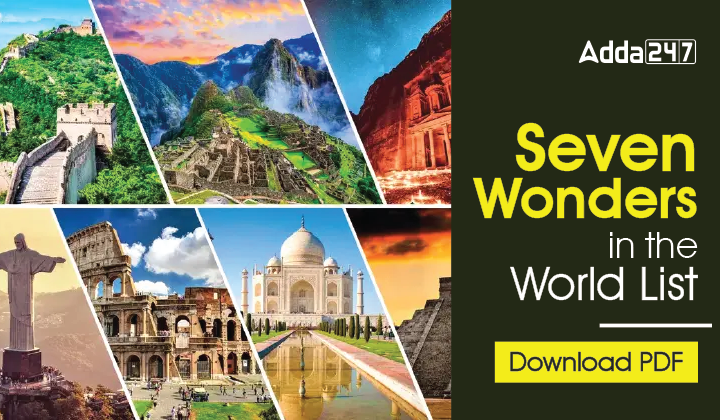
Seven Wonders in the World is one of the most important and significant topics when it comes to the General Awareness Section of any Government Teaching Exam. Candidates preparing for the Teaching Job Exams must have an in-depth idea of the Seven Wonders in the World along with other trending and static General Knowledge questions. In the following article, you will find all the detailed information regarding the Seven Wonders in the world List.
Seven Wonders in the World
The Seven Wonders in the World List includes the Taj Mahal, Petra, the Colosseum, Machu Picchu, the Great Wall of China, Christ the Redeemer, and Chichén Itzá. A Swiss foundation in 2000, launched a campaign to determine the New Seven Wonders in the World as the old Seven Wonders in the World list was created in the 2nd century and only the Pyramids of Giza is the only monument still standing from the original lits. Therefore, it was time to update the Seven Wonders of the World List.
New Seven Wonders in the world List
Here is the New Seven Wonders in the world List. in the following list, you find all the Seven Wonders of the World as per the changes made in 2007.
| Monument/ Site | Location | Built In |
| Great Wall of China | Northern China | 14th through 17th centuries AD |
| Chichén Itzá | Yucatán Peninsula | 6th century |
| Petra | Jordan | 7000 BC (Approx) |
| Machu Picchu | Cuzco, Peru | 15th Century |
| Christ the Redeemer | Rio de Janeiro, Brazil | 1922- 1931 |
| Colosseum | Rome, Italy | 72 AD- 96 AD |
| Taj Mahal | Agra, India | 1631- 1653 |
Seven Wonders in the world List with Description
In the following section, you will find a detailed description on each of the Seven Wonders of the World. Read carefully to know more about the Seven Wonders of the World in-depth.
Great Wall of China
The Great Wall of China covers a distance of 21,196.18 km. it is a series of walls and fortifications located in Northern China. The primary objective of building the Great Wall of China was to protect the region against invaders. It was built 500 years ago during the Ming Dynasty. The construction of the Great Wall of China continued for almost 2 millennia as various emperors of China built it. It is UNESCO Worl Heritage Site and thousands of tourists visit the Great Wall of China throughout the year.
Chichén Itzá
The Mayan People of the Yucatán Peninsula built the Chichén Itzá in the 6th century. The Chichén Itzá is a complex of ruins of various structures like temples, ball courts and other structures. Among the most notable is the stepped pyramid El Castillo (“The Castle”), which rises 79 feet (24 meters) above the Main Plaza. It is located in the Tinúm Municipality, Yucatán State, Mexico. Chichén Itzá was the largest Mayan City and it was the focal point of the Northern Mayan Lowland from the Late Classic (c. AD 600–900) through the Terminal Classic (c. AD 800–900) and into the early portion of the Postclassic period (c. AD 900–1200.
Petra
Petra is located in a remote valley surrounded by sandstones mountains and cliffs in Jordan and its inhabitants called it Raqmu or Raqēmō. This archaeological city in southern Jordan has been inhibited since 7000 BC. Based on archaeological evidence, by the 2nd century, Nabataean (nomadic Arabs) made Petra the capital of their Kingdom to boost their trade through the incense trade routes. Petra flourished as their capital and major trade centre. At its pinnacle, the Nabataeans chiselled out dwelling places, temples, and tombs into the sandstones. One of the attractions of the sandstone is that it changes colours with the shifting sun throughout the day. Petra was abandoned by the inhabitants after two major earthquakes and a significant change in the trade route. The archaeological site was majorly neglected by archaeologists until the early 20th Century, although it was rediscovered in 1912.
Machu Picchu
Discovered in 1911 by Hiram Bingham, Machu Picchu is an Incan site near Cuzco, Peru. Machu Picchu is one of the major Pre-Columbian ruins found nearly intact despite its isolation in the high Andes mountains through the centuries. Its major features like agricultural terraces, plazas, residential areas, and temples are still in good shape. Machu Picchu is a 15th Century citadel located more than 7000 feet above sea level. Since 1983, Machu Picchu is a designated UNESCO World Heritage Site and it is one of the most visited tourist destinations in Peru. In 2007, Machu Picchu was included in the list of Seven Wonders of the World. Machu Picchu is a Temple Sun and it was sacred to the Incas.
Christ the Redeemer
The colossal monument of Jesus Christ that stands atop Mount Corcovado in Rio de Janeiro, Brazil is called Christ the Redeemer. The construction of Christ the Redeemer began in 1922 and it took 9 years to complete it. The monument was opened on 12th October 1931 with a grand opening ceremony where the statue was lit by a battery of floodlights turned on remotely by Italian shortwave radio inventor Guglielmo Marconi. Local engineer Heitor da Silva Costa and artist Carlos Oswald designed the statue of Christ the Redeemer. French sculptor Paul Landowski created the work. The Christ the Redeemer was included in the list of Seven Wonders of the World in 2007 and it is also a National Historic Heritage of Brazil.
Colosseum
Located at the centre of the city of Rome, Colosseum is an oval-shaped amphitheatre order to be built by Emperor Vespasian in 72 AD. The construction ended in 80 AD however, further modifications were made to the Colosseum until 96 AD. The amphitheatre was built to hold 50000 to 80000 spectators. The Colosseum is the largest standing amphitheatre in the World as its measures 620 by 513 feet (189 by 156 meters) and it includes a complex system of vaults. Some of the important events that were held in the Colosseum are the famous gladiator contests, animal hunts, executions, dramas based on Roman Mythology and enactment of the famous battle
Taj Mahal
Commissioned by the Mughal Emporer Shah Jahan in 1631 to house the tomb of his favourite wife Mumtaz Mahal, the Taj Mahal is ivory- a white marble mausoleum. Taj Mahal is located at the bank of river Yamuna in the city of Agra, India. Though it was essentially complete in 1643, however, it was complete in its complete entirety along with its gardens and other structures in 1653. The Taj Mahal Complex includes huge gardens, a guest house, and a mosque. It is situated on 17 hectares (42 acres). It is a marvellous architectural monument flaunting the best of Indo-Islamic architecture and designs with massive influence of early Mughal architecture as well. Since 1983, the Taj Mahal is World Heritage Site. It also houses the tomb of Shah Jahan himself as he was buried beside his wife after his death in 1666 AD.
Old Seven Wonders in the World
The Old Seven Wonders of the World were a collection of remarkable and awe-inspiring structures that captivated the ancient world. These wonders, celebrated for their architectural brilliance and cultural significance, included the Great Pyramid of Giza in Egypt, the Hanging Gardens of Babylon in present-day Iraq, the Statue of Zeus at Olympia in Greece, the Temple of Artemis at Ephesus in Turkey, the Mausoleum at Halicarnassus in present-day Turkey, the Colossus of Rhodes in Greece, and the Pharos (Lighthouse) of Alexandria in Egypt. Each of these marvels represented human ingenuity and artistic mastery, leaving an indelible mark on history. While most of these ancient wonders no longer stand, their legacy continues to inspire awe and wonder in the minds of people across the globe.
Old Seven Wonders in the World List
Here is the list of Old Seven Wonders in the World.
- Pyramids of Giza
- Hanging Gardens of Babylon
- Statue of Zeus
- Temple of Artemis
- Mausoleum of Halicarnassus
- Colossus of Rhodes
- Pharos of Alexandria










